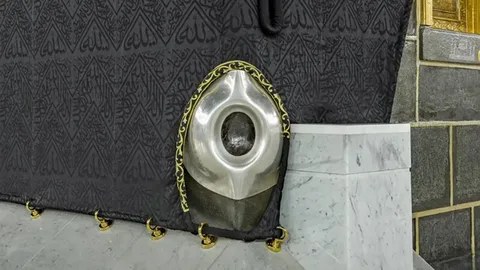For centuries, millions of Muslims have journeyed to Makkah to perform Hajj and Umrah, with one of the most profound experiences being the chance to witness and touch the Hajr-e-Aswad, also known as the Black Stone. Positioned in the eastern corner of the Kaaba, the Hajr-e-Aswad in Makkah holds deep historical, religious, and spiritual significance. Beyond its physical presence, it carries timeless lessons that continue to inspire believers across the globe.
In this article, we will explore the top 5 spiritual lessons from Hajr-e-Aswad, understand its history, and reflect on why this sacred stone remains a symbol of devotion, humility, and eternal faith.
The History and Significance of Hajr-e-Aswad in Makkah
The Hajr-e-Aswad is believed to have descended from Paradise, a stone of purity that was once dazzling white but later turned black due to the sins absorbed from humanity. Placed in the Kaaba by Prophet Ibrahim (AS) and his son Prophet Ismail (AS) under the command of Allah, it has been honored as a cornerstone of Islamic tradition.
Muslims across the world seek the best view of Hajr-e-Aswad in Makkah when they perform Tawaf, longing to kiss it, touch it, or raise their hand in respect while passing it. Its presence reminds believers of their connection to Allah, the prophets, and the eternal message of submission.
1. Lesson of Humility and Submission
When pilgrims approach the Hajr-e-Aswad in Makkah, they come with complete humility, bowing to touch or kiss the sacred stone. This act teaches us that no matter how wealthy, powerful, or educated a person is, before Allah, everyone is equal.
The Hajr-e-Aswad symbolizes surrender to the Creator, reminding believers that spiritual fulfillment is found in submission, not arrogance. It strips away worldly pride and helps Muslims return to the essence of faith—obedience to Allah alone.
2. Reminder of Unity Among Believers
One of the most striking spiritual lessons from the Hajr-e-Aswad is the reminder of Muslim unity. Every year, millions of people from diverse backgrounds stand together, seeking the same goal: to please Allah.
When pilgrims gather around the Kaaba, striving for even the best view of Hajr-e-Aswad in Makkah, they reflect the brotherhood of Islam. The stone becomes a symbol of how believers should rise above cultural, racial, and social differences to form a united community of faith.
3. Symbol of Repentance and Renewal
The transformation of the Hajr-e-Aswad from white to black is not just a historical event; it is a deep spiritual lesson. It teaches that sins darken the soul, but turning back to Allah through repentance brings renewal and forgiveness.
For pilgrims, touching or even seeing the Hajr-e-Aswad in Makkah becomes an emotional moment of seeking forgiveness. It inspires believers to cleanse their hearts and lives, returning home from Makkah with renewed faith and commitment.
4. Connection to the Prophets
Another profound lesson from the Hajr-e-Aswad is its direct connection to the prophets. From Prophet Ibrahim (AS) placing the stone, to Prophet Muhammad (SAW) honoring it during Tawaf, the Black Stone stands as a timeless link between generations of believers and the messengers of Allah.
The act of looking at or approaching the Hajr-e-Aswad in Makkah allows Muslims to feel a closeness to their spiritual heritage. It reminds them to live in the footsteps of the prophets by practicing patience, sincerity, and devotion.
5. Reminder of the Day of Judgment
The Hajr-e-Aswad will testify on the Day of Judgment for those who touched or kissed it with sincerity. This powerful reminder gives Muslims hope and accountability at the same time.
When pilgrims strive for the best view of Hajr-e-Aswad in Makkah, they are reminded that every sincere act of worship is recorded and will hold weight in the Hereafter. It pushes believers to lead lives of piety, mindfulness, and constant remembrance of Allah.
Why Visiting Hajr-e-Aswad in Makkah is a Transformative Experience
Visiting Makkah is more than a journey of the body—it is a journey of the soul. Witnessing the Hajr-e-Aswad leaves a lifelong impression. Many Muslims describe it as the most emotional and spiritual moment of their lives, one that strengthens their faith and changes their outlook forever.
For those who long for the best view of Hajr-e-Aswad in Makkah, the experience becomes a bridge between the physical world and the unseen, reminding them of Allah’s mercy, forgiveness, and eternal guidance.
Practical Tips for Pilgrims Seeking Hajr-e-Aswad in Makkah
- Approach with sincerity and patience, avoiding harm to others in the crowd.
- If you cannot kiss or touch the Hajr-e-Aswad, simply raise your hand and say “Bismillah Allahu Akbar.”
- Focus on the spiritual connection rather than physical contact, as intention matters most.
- Reflect on its lessons rather than just the ritual act.
Company Note
For believers planning their journey, agencies like crt travel assist pilgrims in experiencing the sacred journey with ease and devotion. With proper guidance, your visit to the Hajr-e-Aswad in Makkah can become an unforgettable spiritual highlight. Organizations such as crt travel ensure pilgrims focus on worship while the arrangements are smoothly handled.
FAQs about Hajr-e-Aswad in Makkah
- What is the significance of Hajr-e-Aswad in Islam?
The Hajr-e-Aswad is believed to be a stone from Paradise, placed in the Kaaba by Prophet Ibrahim (AS) and honored by Prophet Muhammad (SAW). It symbolizes submission, unity, and forgiveness. - Can every pilgrim kiss the Hajr-e-Aswad in Makkah?
Due to large crowds, not everyone can physically kiss or touch the stone. However, raising the hand towards it with “Bismillah Allahu Akbar” carries the same reward. - Why did the Hajr-e-Aswad turn black?
It was originally a white stone from Paradise but turned black by absorbing the sins of humanity. This change carries a powerful lesson about sin, repentance, and mercy. - Will the Hajr-e-Aswad have a role on the Day of Judgment?
Yes, according to Hadith, the stone will testify for those who touched or kissed it with sincerity. - How can I get the best view of Hajr-e-Aswad in Makkah?
The best time is usually during less crowded hours, such as early mornings or late nights, when Tawaf is easier. Planning with a reliable travel guide also helps pilgrims get closer views.


